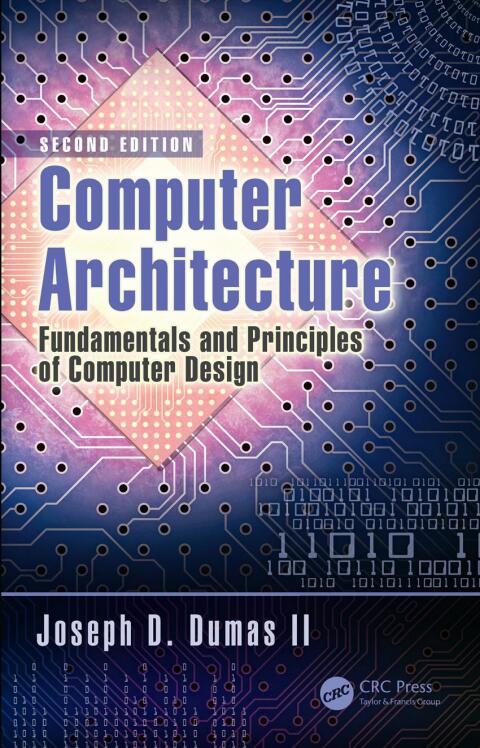Description
Efnisyfirlit
- Cover Page
- Title Page
- Copyright Page
- Dedication Page
- Contents
- Preface
- Acknowledgments
- Author
- Chapter 1 Introduction to computer architecture
- 1.1 What is computer architecture?
- 1.1.1 Architecture versus implementation
- 1.2 Brief history of computer systems
- 1.2.1 The first generation
- 1.2.2 The second generation
- 1.2.3 The third generation
- 1.2.4 The fourth generation
- 1.2.5 The fifth generation
- 1.2.6 Modern computing: the sixth generation
- 1.3 Types of computer systems
- 1.3.1 Single processor systems
- 1.3.2 Parallel processing systems
- 1.3.3 Special architectures
- 1.4 Quality of computer systems
- 1.4.1 Generality and applicability
- 1.4.2 Ease of use
- 1.4.3 Expandability
- 1.4.4 Compatibility
- 1.4.5 Reliability
- 1.5 Success and failure of computer architectures and implementations
- 1.5.1 Quality and the perception of quality
- 1.5.2 Cost issues
- 1.5.3 Architectural openness, market timing, and other issues
- 1.6 Measures of performance
- 1.6.1 CPU performance
- 1.6.2 Memory system performance
- 1.6.3 I/O system performance
- 1.6.4 Power performance
- 1.6.5 System benchmarks
- 1.7 Chapter wrap-up
- Chapter 2 Computer memory systems
- 2.1 The memory hierarchy
- 2.1.1 Characteristics of an ideal memory
- 2.1.2 Characteristics of real memory devices
- 2.1.3 Hierarchical memory systems
- 2.2 Main memory interleaving
- 2.2.1 High-order interleaving
- 2.2.2 Low-order interleaving
- 2.3 Logical organization of computer memory
- 2.3.1 Random access memories
- 2.3.2 Sequential access memories
- 2.3.3 Associative memories
- 2.4 Cache memory
- 2.4.1 Locality of reference
- 2.4.2 Hits, misses, and performance
- 2.4.3 Mapping strategies
- 2.4.4 Cache write policies
- 2.4.5 Cache replacement strategies
- 2.4.6 Cache initialization
- 2.5 Memory management and virtual memory
- 2.5.1 Why virtual memory?
- 2.5.2 Virtual memory basics
- 2.5.3 Paged virtual memory
- 2.5.4 Segmented virtual memory
- 2.5.5 Segmentation with paging
- 2.5.6 The MMU and TLB
- 2.5.7 Cache and virtual memory
- 2.6 Chapter wrap-up
- Chapter 3 Basics of the central processing unit
- 3.1 The instruction set
- 3.1.1 Machine language instructions
- 3.1.2 Functional categories of instructions
- 3.1.3 Instruction addressing modes
- 3.1.4 Number of operands per instruction
- 3.1.5 Memory-register versus load-store architectures
- 3.1.6 CISC and RISC instruction sets
- 3.2 The datapath
- 3.2.1 The register set
- 3.2.2 Integer arithmetic hardware
- 3.2.2.1 Addition and subtraction
- 3.2.2.2 Multiplication and division
- 3.2.3 Arithmetic with real numbers
- 3.2.3.1 Why use floating-point numbers?
- 3.2.3.2 Floating-point representation
- 3.2.3.3 Floating-point arithmetic hardware
- 3.3 The control unit
- 3.3.1 A simple example machine
- 3.3.2 Hardwired control unit
- 3.3.3 Microprogrammed control unit
- 3.4 Chapter wrap-up
- Chapter 4 Enhancing CPU performance
- 4.1 Pipelining
- 4.2 Arithmetic pipelines
- 4.3 Instruction unit pipelines
- 4.3.1 Basics of an instruction pipeline
- 4.3.2 Control transfers and the branch penalty
- 4.3.3 Branch prediction
- 4.3.4 Delayed control transfers
- 4.3.5 Memory accesses: delayed loads and stores
- 4.3.6 Data dependencies and hazards
- 4.3.7 Controlling instruction pipelines
- 4.4 Characteristics of RISC machines
- 4.5 Enhancing the pipelined CPU
- 4.5.1 Superpipelined architectures
- 4.5.2 Superscalar architectures
- 4.5.3 Very long instruction word (VLIW) architectures
- 4.5.4 Multithreaded architectures
- 4.6 Chapter wrap-up
- Chapter 5 Exceptions, interrupts, and input/output systems
- 5.1 Exceptions
- 5.1.1 Hardware-related exceptions
- 5.1.1.1 Maskable interrupts
- 5.1.1.2 Nonmaskable interrupts
- 5.1.1.3 Watchdog timers and reset
- 5.1.1.4 Nonvectored, vectored, and autovectored interrupts
- 5.1.2 Software-related exceptions
- 5.2 Input and output device interfaces
- 5.3 Program-controlled I/O
- 5.3.1 Memory-mapped I/O
- 5.3.2 Separate I/O
- 5.4 Interrupt-driven I/O
- 5.5 Direct memory access
- 5.6 Input/output processors
- 5.7 Real-world I/O example: the universal serial bus
- 5.8 Chapter wrap-up
- Chapter 6 Parallel and high-performance systems
- 6.1 Types of computer systems: Flynn’s taxonomy
- 6.1.1 Vector and array processors
- 6.1.2 GPU computing
- 6.1.3 Multiprocessor systems
- 6.1.4 Multicomputer systems
- 6.2 Interconnection networks for parallel systems
- 6.2.1 Purposes of interconnection networks
- 6.2.2 Interconnection network terms and concepts
- 6.2.2.1 Master and slave nodes
- 6.2.2.2 Circuit switching versus packet switching
- 6.2.2.3 Static and dynamic networks
- 6.2.2.4 Centralized control versus distributed control …316
- 6.2.2.5 Synchronous timing versus asynchronous timing
- 6.2.2.6 Node connection degree
- 6.2.2.7 Communication distance and diameter
- 6.2.2.8 Cost, performance, expandability, and fault tolerance
- 6.2.3 Bus-based interconnections
- 6.3 Static interconnection networks
- 6.3.1 Linear and ring topologies
- 6.3.2 Star networks
- 6.3.3 Tree and fat tree networks
- 6.3.4 Nearest-neighbor mesh
- 6.3.5 Torus and Illiac networks
- 6.3.6 Hypercube networks
- 6.3.7 Routing in static networks
- 6.4 Dynamic interconnection networks
- 6.4.1 Crossbar switch
- 6.4.2 Recirculating networks
- 6.4.3 Multistage networks
- 6.4.3.1 Blocking, nonblocking, and rearrangeable networks
- 6.5 Chapter wrap-up
- Chapter 7 Special-purpose and future architectures
- 7.1 Dataflow machines
- 7.2 Artificial neural networks
- 7.3 Fuzzy logic architectures
- 7.4 Quantum computing
- 7.5 Chapter wrap-up
- Appendix: reference and further reading materials with web links
- Index






Reviews
There are no reviews yet.